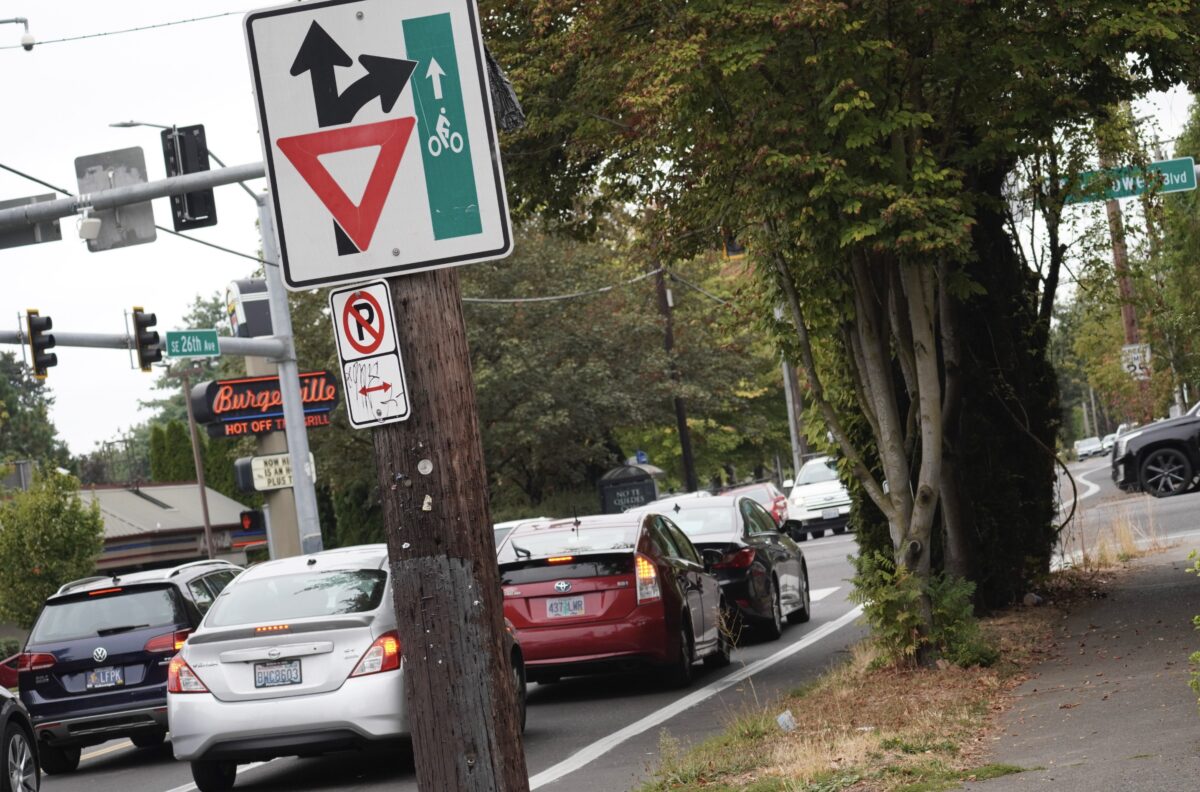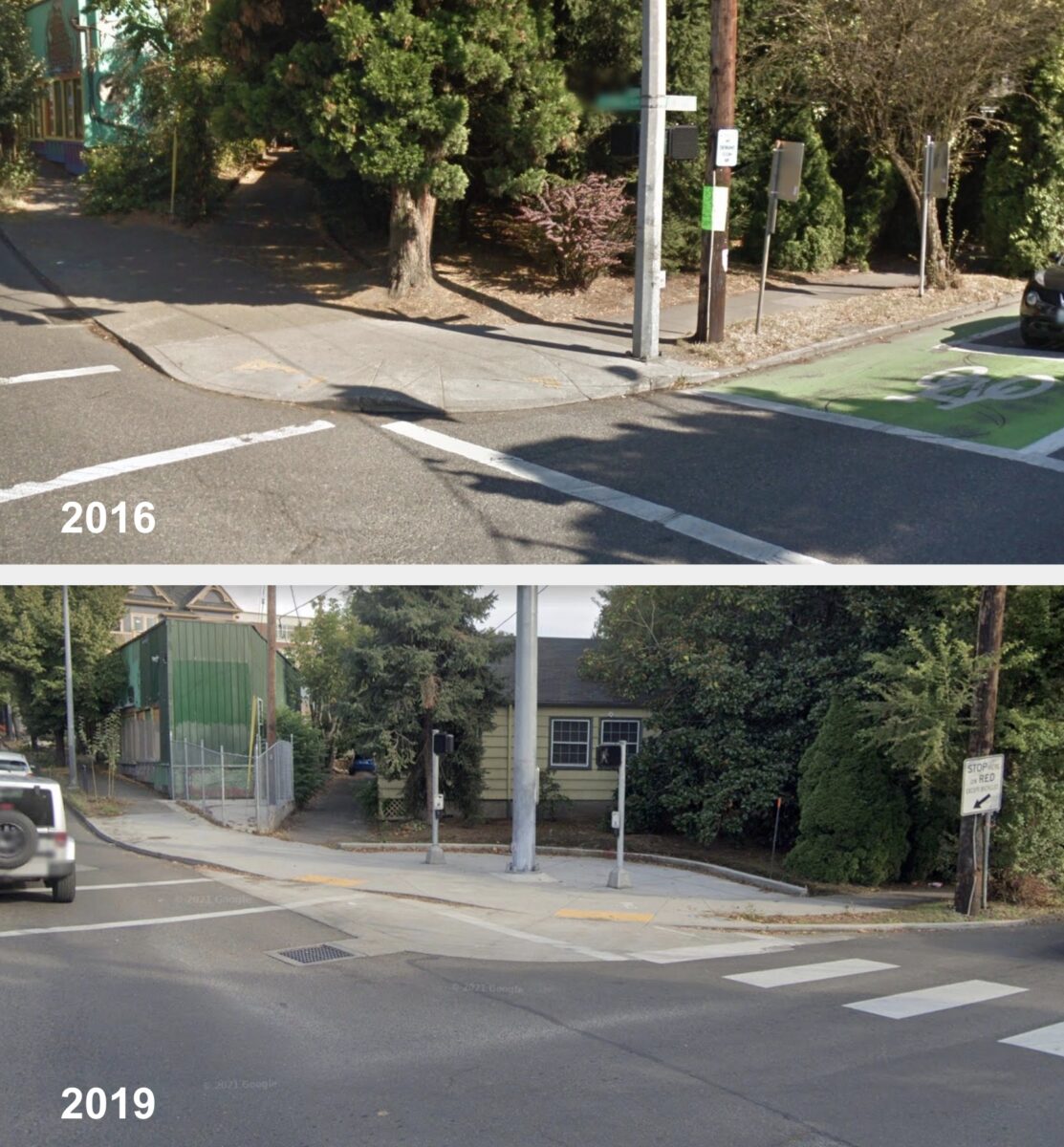“That truck and that trailer really is not made for 26th at all.”
– Keith Wilson, TITAN Freight Systems
Note: Not all the details of this tragedy are yet known. I am only confident in the truck operator’s movement prior to the collision; but there are still unknowns about Sarah’s final moments.
Let’s talk about truck traffic at Southeast 26th and Powell Blvd and how it relates to the death of Sarah Pliner.
Last Tuesday, Sarah was biking toward the southeast corner of that intersection just before 12 noon. It was a school day and dozens of Cleveland High School students milled around — in the crosswalks and at Powell Park, which is catty-corner from the school and a popular place to hang out during lunch period.
As Sarah made her way to the corner (she approached it from the east, but we don’t know where exactly she came from), a man driving a 53-foot semi-truck with a trailer attached was traveling northbound on SE 26th Avenue. The truck operator made a right turn to continue eastbound on Powell (a state highway). Because of the limited space available, and based on where his truck ultimately came to rest (the left of two lanes facing eastbound on Powell), it’s likely that the truck driver swung out wide to the left and then turned back sharply to the right in order to complete the turn. Sometime during this movement, Sarah came in contact with the truck and was killed.
This type of turn, sometimes called a jug handle, is inherently dangerous because it can fool other road users into thinking the truck is headed left or straight, when it’s really just prepping to turn hard to the right. When that hard turn to the right happens, the rear of the trailer does what’s known as “off-tracking” where the wheels cut into the corner. A similar turning movement contributed to the death of Kathryn Rickson on SW Madison in 2012 and a serious injury collision on the downtown transit mall in 2010.
The swerve of a jug handle turn is a well-known risk among truck drivers. In driver forums there’s a lot of discussion about how to perform these turns and the consequences when things go wrong.
We still don’t know exactly what happened on Tuesday, but I think there’s a chance Sarah rolled into a space she thought was safe initially, only to run out of time once that window of safety quickly closed.
Either way, the presence of the truck is what killed Sarah Pliner. So why was the truck there? Is it even possible to make that turn safely? Did the design of that corner contribute to this outcome?
To get a handle on these questions, I reached out to Gregg Dal Ponte and Keith Wilson, who have 70 years of combined experience in the trucking industry. Dal Ponte is director of regulatory compliance with Oregon Trucking Associations Inc., an influential trade organization. Before the OTA, Dal Ponte spent time as a truck driver and sales rep for a trucking company. The majority of his career, 27 years, was spent at the Oregon Department of Transportation where he was administrator of the Motor Carrier Transportation Division in charge of vehicle regulation, truck and driver safety, size and weight enforcement, and so on. Keith Wilson is the president and CEO of TITAN Freight Systems, a company he has been at the helm of for over 24 years. He is also a member of the City of Portland Freight Advisory Committee and ran for a position on Portland City Council in 2020.
Both of these experts told me the infrastructure is inherently problematic.
Trucks on 26th
There are a lot of truck drivers that use 26th Avenue and Powell Blvd. The reasons are obvious once you zoom out on the map. The main office and a distribution center for the Fred Meyer supermarket chain is just 600 feet away. Union Pacific’s 110-acre Brooklyn Intermodal Rail Yard is just a half-mile away. Powell offers direct connections to the Interstate Freeway system to the west and east.
Despite its industrial proximity, 26th Ave is not an official freight route. ODOT says it’s a “major collector”, not a freight route, and the City of Portland’s Transportation System Plan routes freight trucks to Holgate Blvd and McLoughlin — not 26th.
Even so, truckers continue to use 26th and make these turns to-and-from Powell.
That’s a big problem, according to both Dal Ponte and Wilson.
Turning the corner
Dal Ponte explained that truck turning radii are a function of the distance between the king pin (where the trailer attaches to the rear of the truck body) to the rear axle (or king pin to rear axle, KPRA). “The shorter that measurement is, the easier the vehicle makes turns common to an urban setting. The bigger the KPRA, the less likely it’s going to make good turning movements,” he said.
Many 53-foot trucks have sliding dual axles, which means the operator can move the axle fore or aft depending on the weight of the load. This can effectively shorten or lengthen the KPRA, thus changing a truck operators’ possible turning radius. The position of the axles also impacts the weight capacity of the trailer. A longer KPRA measurement, which leads to more dangerous turns, allows truckers to carry heavier (more profitable) loads. Dal Ponte said this sets up “competing interests” because if freight companies used safer trucks, they’d have to make more trips.
“An urban driver is going to have a hard time making corners with the axles all the way back… the danger is when you’re making that right-hand turn in certain geometries, your rear trailer and tandem [rear] axles are going to jump the curb cut across the sidewalk,” he added. “That’s just geometry, but it’s also not safe.”
Wilson, whose company operates trucks out of seven terminals across Oregon and Washington, said their policy would not allow a truck like the one that killed Sarah Pliner to be operated on 26th. “That driver had a 53-foot box,” Wilson said, “there is no physical way he could have made that corner without going into the oncoming lane to prep… That truck and that trailer really is not made for 26th at all.”
In 2015, ODOT realized this corner was unsafe and they spent part of the $4.6 million Powell Blvd Safety Project budget to address it. ODOT felt the corner didn’t have enough space to safely accommodate the large groups of students. They also knew that truck operators would routinely turn right from 26th Avenue to Powell and their rear wheels would mount the curb and roll up onto the sidewalk. To address these concerns, they cut back vegetation and made a larger concrete waiting area. ODOT also cut out the existing curb and replaced it with a “truck apron” and much wider turn radius.
ODOT said this would, “Increase safety by allowing large vehicles to turn without entering the pedestrian zone or encroaching on vehicle lanes.” Not only do truck operators still encroach on other lanes to make these turns, it’s not clear if the new corner design is actually any safer. ODOT has removed an obstacle (the tight corner and curb) and now truck and car drivers are able to take the turn at higher speeds with less consequence.
Prior to our conversation, Wilson visited the corner. When I asked him about the changes ODOT made in 2018 he said, “On balance, I don’t see it as a real positive… I don’t see it as an improvement.” Wilson pointed to the new curb ramps and added that, “Kids or people are standing right there with no protection. Those dual axles are very dangerous. There’s no doubt about it.”
If 26th is so problematic, why not ban trucks?
Wilson thinks any attempt to prohibit trucks from accessing Powell from 26th will just create other problems. “You’d simply push the traffic to an adjacent street,” he said. “Freight needs to play in that sandbox with those other vehicles because it’s a quasi-industrial area,” Wilson added, listing off the rail yard and the Fred Meyer headquarters.
Dal Ponte was more open to the idea of a possible ban on trucks. He said if he was still working at ODOT, he’d consider routing them off of 26th, or at least limiting the length and/or size of trucks allowed to use it. “I’d pinpoint the shippers and receivers in the area and see if an alternate truck route was viable.” Dal Ponte said any new freight truck regulation would be strongly resisted by business interests, but it would be worth it. “Shippers won’t like it because the costs would go up… but what value would somebody place on a life like this person that died?” he said.
Portland Bureau of Transportation Director Chris Warner talked about this on Oregon Public Broadcasting’s Think Out Loud radio program today. He said he’d, “Look at ways to move that [freight traffic] back to Holgate and not use 26th as a throughput.”
Focus on the infrastructure, not the trucks
Wilson and Dal Ponte had different ideas about where our focus on solutions should be placed.
Let’s start with Wilson. He thinks we’d be smartest to change the infrastructure so that truck operators can make safer turns.
Currently, there are two travel lanes on northbound 26th at Powell and one striped shoulder. (There used to be a narrow bike lane that led to a bike box at this corner. In 2018, ODOT removed the bike box and reclassified the bike lane as a “safety shoulder” in their effort to discourage bike riders from using 26th.)
Wilson thinks ODOT should make the lanes safer for bike riders and everyone else. To do that, he recommends removing the left turn lane in order to give more separation between users and give truck drivers the space to make right turns without having to do the jug handle maneuver. “The left turn lane shouldn’t be there,” Wilson said. “You can’t have a built environment with pedestrians, bikes and trucks sharing that same unprotected area. It’s just a recipe for disaster.”
“With just one lane [in each direction] it may impede the traffic flow a little bit, but then you’re able to have a lot larger bike lane.” “You have to look at what is your priority,” Wilson continued. “And if it’s only congested during that one hour in the morning, then our focus should be protecting pedestrians and protecting bikes.”
Focus on the trucks, not the infrastructure
Dal Ponte thinks, “There’s a insufficient land and inadequate financing to change the infrastructure,” so he’d focus on better regulation of existing truck traffic.
Unlike California, Oregon doesn’t use the KPRA ratio to regulate trucks on highways. Instead, they use only overall length. Dal Ponte thinks that’s a mistake because it doesn’t allow for “nuance” in policymaking. Dal Ponte said if ODOT used that ratio they could create a new policy that only trucks with a certain maximum KPRA measurement are allowed to use inner Powell.
While he studied a potential size restriction, Dal Ponte said he’d take immediate action to ban trucks with the longer trailers from using 26th altogether. “I think more trucks that can safely make the turn are better than fewer trucks that can’t. Right?” he said.
In the week since Sarah’s death, we’ve been able to direct tremendous scrutiny onto ODOT and this terrible intersection. The comments made by ODOT Director Kris Strickler Monday are a positive sign that there might be an opportunity for significant change (“To keep our community safe, no change is off the table,” he said).
While there’s a lot of work and big decisions ahead, it feels like almost everyone agrees the current infrastructure is broken and it must be fixed as soon as possible.
“The root of this problem is that the infrastructure is old,” Dal Ponte shared with me. “And it was never designed optimally for the mix of uses it sees today. Something’s got to give.”









